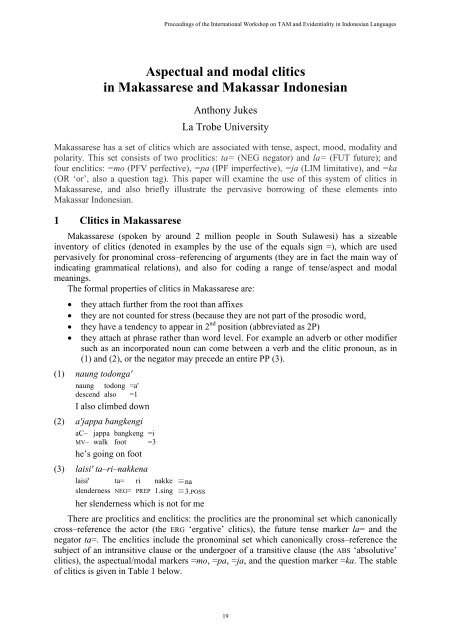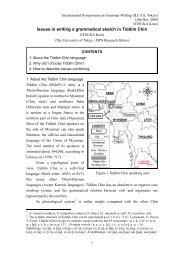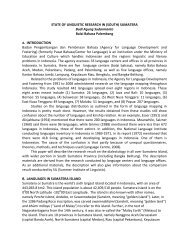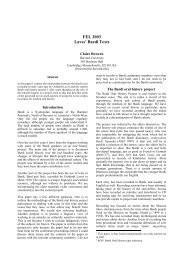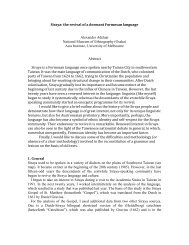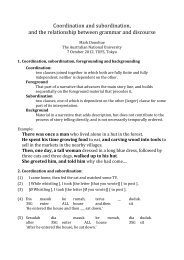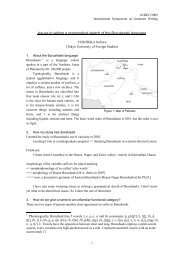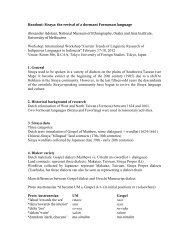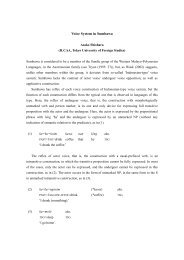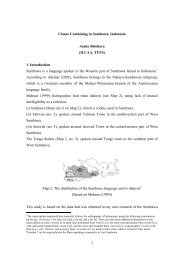Aspectual and modal clitics in Makassarese and Makassar Indonesian
Aspectual and modal clitics in Makassarese and Makassar Indonesian
Aspectual and modal clitics in Makassarese and Makassar Indonesian
You also want an ePaper? Increase the reach of your titles
YUMPU automatically turns print PDFs into web optimized ePapers that Google loves.
<strong>Aspectual</strong> <strong>and</strong> <strong>modal</strong> <strong>clitics</strong><br />
<strong>in</strong> <strong><strong>Makassar</strong>ese</strong> <strong>and</strong> <strong>Makassar</strong> <strong>Indonesian</strong><br />
Anthony Jukes<br />
La Trobe University<br />
<strong><strong>Makassar</strong>ese</strong> has a set of <strong>clitics</strong> which are associated with tense, aspect, mood, <strong>modal</strong>ity <strong>and</strong><br />
polarity. This set consists of two pro<strong>clitics</strong>: ta= (NEG negator) <strong>and</strong> la= (FUT future); <strong>and</strong><br />
four en<strong>clitics</strong>: =mo (PFV perfective), =pa (IPF imperfective), =ja (LIM limitative), <strong>and</strong> =ka<br />
(OR ‘or’, also a question tag). This paper will exam<strong>in</strong>e the use of this system of <strong>clitics</strong> <strong>in</strong><br />
<strong><strong>Makassar</strong>ese</strong>, <strong>and</strong> also briefly illustrate the pervasive borrow<strong>in</strong>g of these elements <strong>in</strong>to<br />
<strong>Makassar</strong> <strong>Indonesian</strong>.<br />
1 Clitics <strong>in</strong> <strong><strong>Makassar</strong>ese</strong><br />
<strong><strong>Makassar</strong>ese</strong> (spoken by around 2 million people <strong>in</strong> South Sulawesi) has a sizeable<br />
<strong>in</strong>ventory of <strong>clitics</strong> (denoted <strong>in</strong> examples by the use of the equals sign =), which are used<br />
pervasively for pronom<strong>in</strong>al cross–referenc<strong>in</strong>g of arguments (they are <strong>in</strong> fact the ma<strong>in</strong> way of<br />
<strong>in</strong>dicat<strong>in</strong>g grammatical relations), <strong>and</strong> also for cod<strong>in</strong>g a range of tense/aspect <strong>and</strong> <strong>modal</strong><br />
mean<strong>in</strong>gs.<br />
The formal properties of <strong>clitics</strong> <strong>in</strong> <strong><strong>Makassar</strong>ese</strong> are:<br />
• they attach further from the root than affixes<br />
• they are not counted for stress (because they are not part of the prosodic word,<br />
• they have a tendency to appear <strong>in</strong> 2 nd position (abbreviated as 2P)<br />
• they attach at phrase rather than word level. For example an adverb or other modifier<br />
such as an <strong>in</strong>corporated noun can come between a verb <strong>and</strong> the clitic pronoun, as <strong>in</strong><br />
(1) <strong>and</strong> (2), or the negator may precede an entire PP (3).<br />
(1) naung todonga'<br />
naung todong =a'<br />
descend also =1<br />
I also climbed down<br />
(2) a'jappa bangkengi<br />
aC– jappa bangkeng =i<br />
MV– walk foot =3<br />
he’s go<strong>in</strong>g on foot<br />
(3) laisi' ta–ri–nakkena<br />
laisi' ta= ri nakke ≡na<br />
slenderness NEG= PREP 1.s<strong>in</strong>g ≡3.POSS<br />
her slenderness which is not for me<br />
Proceed<strong>in</strong>gs of the International Workshop on TAM <strong>and</strong> Evidentiality <strong>in</strong> <strong>Indonesian</strong> Languages<br />
There are pro<strong>clitics</strong> <strong>and</strong> en<strong>clitics</strong>: the pro<strong>clitics</strong> are the pronom<strong>in</strong>al set which canonically<br />
cross–reference the actor (the ERG ‘ergative’ <strong>clitics</strong>), the future tense marker la= <strong>and</strong> the<br />
negator ta=. The en<strong>clitics</strong> <strong>in</strong>clude the pronom<strong>in</strong>al set which canonically cross–reference the<br />
subject of an <strong>in</strong>transitive clause or the undergoer of a transitive clause (the ABS ‘absolutive’<br />
<strong>clitics</strong>), the aspectual/<strong>modal</strong> markers =mo, =pa, =ja, <strong>and</strong> the question marker =ka. The stable<br />
of <strong>clitics</strong> is given <strong>in</strong> Table 1 below.<br />
19
<strong>Aspectual</strong> <strong>and</strong> <strong>modal</strong> <strong>clitics</strong> <strong>in</strong> <strong><strong>Makassar</strong>ese</strong> <strong>and</strong> <strong>Makassar</strong> <strong>Indonesian</strong><br />
Clitic pronouns TAM <strong>clitics</strong><br />
ku= =a' 1 la= FUT<br />
nu= =ko 2f ta= NEG<br />
ki= =ki' 2p/1pl.<strong>in</strong>c =mo PFV<br />
=kang 1pl.exc =pa IPF<br />
na= =i 3 =ja LIM<br />
=ka OR<br />
Table 1: Clitics<br />
The <strong>clitics</strong> generally appear <strong>in</strong> a fixed order which can be exemplified briefly with the<br />
follow<strong>in</strong>g:<br />
(4) lakuapamako<br />
la= ku= apa =ma =ko<br />
FUT= 1= what =PFV =2f<br />
now what will I do with you?<br />
(5) takuassengapi<br />
ta= ku= asseng –a =pa =i<br />
NEG= 1= know –SBJV =IPF =3<br />
I don't know it/him/her yet<br />
These examples show that on both sides of the stem <strong>modal</strong> <strong>and</strong> aspectual <strong>clitics</strong> precede<br />
clitic pronouns, which can be illustrated as follows:<br />
⎧ aspect/<strong>modal</strong>⎫<br />
⎨<br />
⎩ proclitic<br />
⎬<br />
⎭<br />
⎧ ERG ⎫ ⎧ aspect/<strong>modal</strong>⎫<br />
= ⎨<br />
⎩ clitic pronoun<br />
⎬ = STEM = ⎨<br />
⎭ ⎩ enclitic<br />
⎬<br />
⎭ =<br />
⎧ ABS ⎫<br />
⎨<br />
⎩ clitic pronoun<br />
⎬<br />
⎭<br />
It appears that each slot may only conta<strong>in</strong> one clitic — which is to say there are (for<br />
<strong>in</strong>stance) no examples <strong>in</strong> which negator ta= <strong>and</strong> future la= appear together, or <strong>in</strong> which<br />
perfective =mo co-occurs with limitative =ja.<br />
The en<strong>clitics</strong> are generally used to cross-reference the subject of an <strong>in</strong>transitive clause (S)<br />
<strong>and</strong> the patient of a transitive clause (P), while the pro<strong>clitics</strong> are used to cross-reference the<br />
agent of a transitive clause (A). For this reason they are, with some caveats, given the labels<br />
absolutive <strong>and</strong> ergative respectively, <strong>and</strong> <strong><strong>Makassar</strong>ese</strong> can be described at least superficially<br />
as a morphologically ergative language. However, there is a great deal of complexity <strong>and</strong><br />
many exceptions to this generalisation.<br />
2 <strong>Aspectual</strong>/<strong>modal</strong> <strong>clitics</strong><br />
The <strong>clitics</strong> which are associated with tense, aspect, mood, <strong>modal</strong>ity <strong>and</strong> polarity (referred<br />
to for convenience as TAM) consist of two pro<strong>clitics</strong>: ta= (NEG negator) <strong>and</strong> la= (FUT future);<br />
<strong>and</strong> four en<strong>clitics</strong>: =mo (PFV perfective), =pa (IPF imperfective), =ja (LIM limitative), <strong>and</strong> =ka<br />
(OR ‘or’, <strong>and</strong> also question tag).<br />
The TAM en<strong>clitics</strong> all behave similarly <strong>in</strong> that they encliticise onto predicates, follow<strong>in</strong>g<br />
the applicatives -i <strong>and</strong> -ang, <strong>and</strong> preced<strong>in</strong>g enclitic pronouns. The TAM en<strong>clitics</strong> will lose<br />
their f<strong>in</strong>al vowel if followed by =a' or =i. 1 The results of the comb<strong>in</strong>ation of TAM <strong>and</strong><br />
pronom<strong>in</strong>al en<strong>clitics</strong> are shown <strong>in</strong> Table 2.<br />
1 With the exception that =ka=i =kai. Vowel-degem<strong>in</strong>ation still applies <strong>in</strong> the case of =ka=a' =ka'.<br />
20
+<br />
1<br />
=a'<br />
1pl.<strong>in</strong>c/2pol<br />
=ki'<br />
1pl.exc<br />
=kang<br />
2fam<br />
=ko<br />
=mo → =ma' =maki' =makang =mako =mi<br />
=pa → =pa' =paki' =pakang =pako =pi<br />
=ja → =ja' =jaki' =jakang =jako =ji<br />
=ka → =ka' =kaki' =kakang =kako =kai<br />
Table 2: TAM <strong>and</strong> pronom<strong>in</strong>al en<strong>clitics</strong><br />
The clitic pronoun =kang for the first person plural exclusive occurs only <strong>in</strong> comb<strong>in</strong>ation<br />
with the TAM en<strong>clitics</strong> <strong>and</strong> not <strong>in</strong> isolation. It should also be po<strong>in</strong>ted out there are numerous<br />
lexical ways of denot<strong>in</strong>g TAM related mean<strong>in</strong>gs — these are not exam<strong>in</strong>ed here.<br />
Out of the six <strong>clitics</strong>, =mo is by far the most commonly used. Us<strong>in</strong>g Shoebox to make a<br />
wordlist <strong>and</strong> concordance from a small subset of the corpus (2948 clauses) showed that =mo<br />
appeared 917 times, =ja 134 times, ta= 96 times, =pa 62 times, la= 39 times <strong>and</strong> =ka just 17<br />
times.<br />
2.1 Negative ta=<br />
Although ta= is not the most common negator, it is the most basic (ie. unambiguously<br />
monomorphemic) whereas the other negators tea, teá, tena <strong>and</strong> taena can be analysed as<br />
grammaticalised compounds. In isolation ta= simply means ‘not’ <strong>and</strong> is equivalent to the<br />
default negator taena (see below), <strong>and</strong> thus most clauses with taena could be recast with ta=<br />
<strong>in</strong>stead, eg. (6) <strong>and</strong> (7):<br />
(6) taena kuássemmi<br />
tena ku= asseng =mo =i<br />
NEG 1= know =PFV =3<br />
I don’t know it anymore, I forgot it<br />
(7) takuasséngami<br />
ta= ku= asseng –a =mo =i<br />
NEG= 1= know –SBJV =PRF =3<br />
I don’t know it anymore, I forgot it<br />
In practice, clauses such as (7) are quite marked <strong>in</strong> the modern language. This may be<br />
partly because the presence of ta= on a verb usually requires the addition of subjunctive -a to<br />
the verb before any en<strong>clitics</strong>, <strong>and</strong> the subjunctive itself is somewhat archaic. In the modern<br />
language ta= is most often found <strong>in</strong> comb<strong>in</strong>ation with the free negators <strong>in</strong> double negative<br />
constructions such as (8) below. These do not require subjunctive -a.<br />
(8) baju keboka taena tanamangéi<br />
baju kebo' ≡a taena ta= na= mange –i<br />
shirt white ≡DEF NEG NEG= 3= go –APPL<br />
Proceed<strong>in</strong>gs of the International Workshop on TAM <strong>and</strong> Evidentiality <strong>in</strong> <strong>Indonesian</strong> Languages<br />
the white shirt goes with everyth<strong>in</strong>g (lit: the white shirt, there’s no it not go<strong>in</strong>g with)<br />
21<br />
3<br />
=i
<strong>Aspectual</strong> <strong>and</strong> <strong>modal</strong> <strong>clitics</strong> <strong>in</strong> <strong><strong>Makassar</strong>ese</strong> <strong>and</strong> <strong>Makassar</strong> <strong>Indonesian</strong><br />
(9) tenamo tau tampaui<br />
tena =mo tau ta= aN– pau =i<br />
NEG =PFV person NEG= AF– story =3<br />
everyone says it (lit: there’s no longer anyone who doesn’t say it)<br />
The use of ta= was much more common <strong>in</strong> the 16 th /17 th century language preserved <strong>in</strong> the<br />
Gowa chronicle, <strong>and</strong> is also not uncommon <strong>in</strong> genres which similarly use archaic/literary<br />
style, such as folk tales (rupama) <strong>and</strong> epic prose (s<strong>in</strong>rili'). From the oldest known manuscript<br />
(KIT 668-216), example (10) is from the Gowa chronicle, while (11) is from article 16 of the<br />
Bungaya treaty of 1667:<br />
(10) anne Karaenga. tanipujiyai. malambusu'. tanipujiyai. panrita.<br />
anne karaeng ≡a ta= ni– puji –a =i ma– lambus =u'<br />
this karaeng ≡DEF NEG= PASS– praise –SBJV =3 STV– upright =EC<br />
ta= ni– puji –a =i panrita<br />
NEG= PASS– praise –SBJV =3 expert<br />
This karaeng was not praised for be<strong>in</strong>g just, was not praised for be<strong>in</strong>g learned.<br />
(KIT:3.07)<br />
(11) ka le'ba' naadóimi manna silawara ruku tania' apa nakana anunna<br />
ka le'ba' na= ado –i =mo =i manna si– lawar =a' ruku<br />
because already 3= agree –APPL =PFV =3 even one– blade =EC grass<br />
ta= nia' apa na= kana anu ≡nna<br />
NEG= exist what 3= say th<strong>in</strong>gy ≡3.POSS<br />
because he (Sultan Hasanudd<strong>in</strong>) already agreed that he has no claim to even one blade<br />
of grass (of Buton): lit. there does not exist anyth<strong>in</strong>g (about which) he says (that is) his<br />
th<strong>in</strong>g<br />
There is an additional usage found only <strong>in</strong> the chronicles, <strong>in</strong> which the comb<strong>in</strong>ation of the<br />
preposition ri <strong>and</strong> ta= prefixed to a verb functions as a k<strong>in</strong>d of irrealis marker, with the<br />
mean<strong>in</strong>g ‘before the time of VERB’, literally ‘at (the time when) not’:<br />
(12) Areng pakaraengang ri tama'gaukang nikana Karaeng Passi'<br />
areng pa> karaeng k<strong>in</strong>g
(14) tanaasseng lanajappáia<br />
ta= na= asseng la= na= jappa –i ≡a<br />
NEG= 3= know FUT= 3= walk –APPL ≡DEF<br />
he doesn't know where he's go<strong>in</strong>g (Or545.48)<br />
(15) lamangea' ri pasaraka ammuko<br />
la= mange =a' ri pasar =a' ≡a ammuko<br />
FUT= go =1 PREP market =EC ≡DEF tomorrow<br />
I’ll go to the market tomorrow<br />
The mean<strong>in</strong>g of the above sentence can also be expressed with a verb derived from pasar<br />
‘market’:<br />
(16) lappasaraka' ammuko<br />
la= aC– pasar =a' =a' ammuko<br />
FUT= MV– market =EC =1 tomorrow<br />
La= is also often found on wh-words such as apa ‘what?’ <strong>and</strong> kere ‘where?’. (17) is the<br />
most common greet<strong>in</strong>g formula, although it is usually shortened to lakeko mae.<br />
(17) lakereko mae<br />
la= kere =ko mae<br />
FUT= where =2f be<br />
where are you go<strong>in</strong>g? (lit. where will you be?)<br />
(18) lakuapako<br />
la= ku= apa =ko<br />
FUT= 1= what =2f<br />
what will I do with you?<br />
The comb<strong>in</strong>ation of la= <strong>and</strong> the perfective enclitic =mo (see below) means that an action<br />
is imm<strong>in</strong>ent.<br />
(19) lakusaremako pa'arengang<br />
la= ku= sare =mo =ko pa> aC– areng MV– name
<strong>Aspectual</strong> <strong>and</strong> <strong>modal</strong> <strong>clitics</strong> <strong>in</strong> <strong><strong>Makassar</strong>ese</strong> <strong>and</strong> <strong>Makassar</strong> <strong>Indonesian</strong><br />
2.3 Perfective =mo<br />
This clitic (which is irregular <strong>in</strong> that its vowel is /o/ rather than /a/ when unaffected by a<br />
follow<strong>in</strong>g enclitic pronoun) has a wide range of functions, the ma<strong>in</strong> one of which is to mark<br />
completion of an action or event, or atta<strong>in</strong>ment of a state. In this way it is the most frequent<br />
marker of past tense, but is also used for f<strong>in</strong>e aspectual dist<strong>in</strong>ctions, as well as some more<br />
obviously discourse/mood related functions such as form<strong>in</strong>g imperatives <strong>and</strong> express<strong>in</strong>g<br />
certa<strong>in</strong>ty. The follow<strong>in</strong>g examples illustrate the core mean<strong>in</strong>g of completion or atta<strong>in</strong>ment.<br />
(21) angnganrema'<br />
aN(N)– kanre =mo =a'<br />
BV– eat =PFV =1<br />
I’ve already eaten<br />
(22) pirambulammi battanta? sibulamma' tacc<strong>in</strong>i' cera'<br />
piraN– bulang =mo =i battang ≡ta<br />
how.many month =PFV =3 belly ≡2p.POSS<br />
si– bulang =mo =a' ta= aC– c<strong>in</strong>i' cera'<br />
one– month =PFV =1 NEG= MV– see blood<br />
How many months have you been pregnant? (lit: how many months your belly?) It’s<br />
already a month s<strong>in</strong>ce I saw any blood (C:840)<br />
In addition, =mo can have a deontic component <strong>and</strong> is commonly used <strong>in</strong> imperatives.<br />
This could be viewed as project<strong>in</strong>g the speaker’s certa<strong>in</strong>ty that an action will be performed.<br />
(23) tunrummi<br />
tunrung =mo =i<br />
hit =PFV =3<br />
go <strong>and</strong> hit him (C:459)<br />
(24) ammempomaki'<br />
amm– empo =mo =ki'<br />
MV– sit =PFV =2p<br />
please sit yourself down (C:459)<br />
On questions, =mo is used when an explicit or certa<strong>in</strong> answer is required. Compare the<br />
follow<strong>in</strong>g:<br />
(25) kerei mae pammantangannu<br />
kere =i mae pa> amm– antang MV– live amm– antang MV– live
When =mo is attached to the negator taena or tena the result is a word mean<strong>in</strong>g ‘no more’<br />
which has scope over the follow<strong>in</strong>g clause.<br />
(28) tenamo nakkulle acc<strong>in</strong>i’<br />
tena =mo na= aC– kulle aC– c<strong>in</strong>i’<br />
NEG =PFV 3= MV– can MV– see<br />
he can’t see any more<br />
If the clause conta<strong>in</strong>s no other elements capable of host<strong>in</strong>g a fronted clitic pronoun,<br />
tenamo may host an enclitic pronoun. In the follow<strong>in</strong>g example the clause consists solely of a<br />
prepositional phrase which cannot host a proclitic.<br />
(29) taenami ri barugaya<br />
taena =mo =i ri baruga ≡a<br />
neg =PFV =3 PREP baruga ≡DEF<br />
Proceed<strong>in</strong>gs of the International Workshop on TAM <strong>and</strong> Evidentiality <strong>in</strong> <strong>Indonesian</strong> Languages<br />
he isn’t <strong>in</strong> the baruga (hall) any more<br />
The comb<strong>in</strong>ation of t<strong>in</strong>ang ‘never’ <strong>and</strong> =mo means ‘never aga<strong>in</strong>’. (T<strong>in</strong>ang also requires<br />
subjunctive -a).<br />
(30) t<strong>in</strong>ang niákkamo nasikat<strong>in</strong>rong karaeng–ba<strong>in</strong>ea<br />
t<strong>in</strong>ang nia' –a =mo na= si– ka> t<strong>in</strong>ro sleep
<strong>Aspectual</strong> <strong>and</strong> <strong>modal</strong> <strong>clitics</strong> <strong>in</strong> <strong><strong>Makassar</strong>ese</strong> <strong>and</strong> <strong>Makassar</strong> <strong>Indonesian</strong><br />
2.5 Limitative =ja<br />
The enclitic =ja means ‘only’ <strong>in</strong> the sense ‘noth<strong>in</strong>g more than’ or ‘noth<strong>in</strong>g other than’.<br />
(35) la'lampaja'<br />
la= aC– lampa =ja =a'<br />
FUT= MV– go =LIM =1<br />
I’m just go<strong>in</strong>g to go<br />
(36) mannantu lompo, lompo bannanji<br />
manna antu lompo lompo bannang =ja =i<br />
although MED big big thread =LIM =3<br />
even if that’s thick, it’s only a thick thread (ie. it may be big, but it’s only big for a<br />
small th<strong>in</strong>g)<br />
(37) manna le'leng ka i katte angkana buleng, bulenji<br />
manna le'leng ka i katte aN– kana buleng buleng =ja =i<br />
although black because PERS you AF– word white white =LIM =3<br />
although black, s<strong>in</strong>ce you say ‘white’, it's noth<strong>in</strong>g but white<br />
2.6 ‘Either/or’ =ka<br />
This clitic groups with the aspectual/<strong>modal</strong> en<strong>clitics</strong> largely because it fits <strong>in</strong>to the same<br />
morphosyntactic slot (between the stem <strong>and</strong> the pronom<strong>in</strong>al enclitic), <strong>and</strong> because it is neither<br />
counted for stress has a stress contour of its own (unlike the otherwise similar hortative<br />
particle sá). However its function is somewhat removed from the other members of the group<br />
<strong>and</strong> it has a significant formal difference <strong>in</strong> that its vowel is not subject to replacement by a<br />
pronom<strong>in</strong>al enclitic’s vowel, thus =ka +=i → kai (*ki).<br />
Cense describes it has hav<strong>in</strong>g a ‘question<strong>in</strong>g’ (vragende) mean<strong>in</strong>g, as did one of my<br />
<strong>in</strong>formants who compared it to the Japanese question particle (which is also co<strong>in</strong>cidentally<br />
ka). 2<br />
However the fact that the vast majority of questions are not marked with =ka makes this<br />
explanation somewhat dubious. There seem to be two major functions: one is as a means of<br />
seek<strong>in</strong>g confirmation or clarification similar to question tags <strong>in</strong> English:<br />
(38) lanaungkako?<br />
la= naung =ka =ko<br />
FUT= descend =or =2f<br />
will you really go down? (C:257)<br />
The other major function of =ka, although less common <strong>in</strong> spoken <strong><strong>Makassar</strong>ese</strong> than the<br />
‘question<strong>in</strong>g’ function, could perhaps be considered more primary. In this, =ka marks options<br />
or possibilities <strong>in</strong> an either/or construction, with each of the alternatives marked with =ka.<br />
Cense gives the partial example tedongka jarangka ‘either buffalo or<br />
horses’ (C:257) but a larger example comes from the preamble to the Gowa Chronicle<br />
(Wolhoff <strong>and</strong> Abdurrahim 1959:9):<br />
(39) Ka punna taniassenga ruai kod<strong>in</strong>a kisa'r<strong>in</strong>gkai kalenta karaeng–dudu na kanaka tau<br />
ipantaraka tau bawang– dudu.<br />
ka punna ta= ni– asseng ≡a rua =i kodi ≡na ki= sa'r<strong>in</strong>g =ka =i<br />
BCS if NEG= PASS– know ≡DEF two =3 bad ≡3.POSS 2p= feel =or =3<br />
2 Most <strong><strong>Makassar</strong>ese</strong> people do not speak Japanese, however this person is a guide for Japanese tourists.<br />
26
kale ≡nta karaeng dudu na kana =ka tau i pantara' ≡a<br />
self ≡2p.POSS k<strong>in</strong>g very <strong>and</strong> word =or person PREP outside ≡DEF<br />
tau bawang dudu<br />
person ord<strong>in</strong>ary very<br />
Because if it is not known, there are two dangers: either we will feel ourselves to be<br />
k<strong>in</strong>gs too, or outsiders will call us common people.<br />
In view of the latter function, it is tempt<strong>in</strong>g to compare the use of =ka on a s<strong>in</strong>gle<br />
predicate to the use of lead<strong>in</strong>g or <strong>in</strong> English, as <strong>in</strong> Do you want to come, or… Note though<br />
that ‘or’ <strong>in</strong> <strong><strong>Makassar</strong>ese</strong> is <strong>in</strong> most cases the lexicalised construction iareka .<br />
3 TAM <strong>clitics</strong> <strong>in</strong> <strong>Makassar</strong> <strong>Indonesian</strong> 3<br />
Along with the pronom<strong>in</strong>al en<strong>clitics</strong> (less so the pro<strong>clitics</strong>), the aspectual <strong>clitics</strong> are used<br />
heavily <strong>in</strong> <strong><strong>Makassar</strong>ese</strong> <strong>Indonesian</strong>. They are used <strong>in</strong> conversation <strong>and</strong> SMS or <strong>in</strong>ternet chat<br />
or Facebook walls. Most obviously <strong>in</strong> conversation, perfective =mi <strong>and</strong> imperfective =pi are<br />
habitually (<strong>and</strong> redundantly) added to the <strong>Indonesian</strong> lexemes sudah <strong>and</strong> belum to give<br />
sudahmi ‘already’ <strong>and</strong> belumpi ‘not yet’. The follow<strong>in</strong>g examples (found on Facebook)<br />
briefly illustrate their use:<br />
(40) Bik<strong>in</strong> apami itu anak2?<br />
What did those kids do?<br />
(41) Pergi ke Lombok? Ke Bali ja. 4<br />
(Did you) go to Lombok? Just to Bali.<br />
(42) Mauma pulang<br />
I already want to go home<br />
Proceed<strong>in</strong>gs of the International Workshop on TAM <strong>and</strong> Evidentiality <strong>in</strong> <strong>Indonesian</strong> Languages<br />
(43) Kerja dimana? Di Butonkoka<br />
Where (do you work)? You <strong>in</strong> Buton?<br />
These examples come from young people who are not themselves fluent <strong>in</strong> <strong><strong>Makassar</strong>ese</strong>,<br />
some not be<strong>in</strong>g of <strong><strong>Makassar</strong>ese</strong> extraction. Nevertheless, they show consistent use of<br />
<strong><strong>Makassar</strong>ese</strong> TAM <strong>clitics</strong>.<br />
Abbreviations of sources for example sentences<br />
The follow<strong>in</strong>g is a list of abbreviations for the most commonly used sources of example<br />
sentences. Those left unspecified are generally from my fieldnotes.<br />
C:pp Makassaars-Nederl<strong>and</strong>s Woordenboek (Cense & Abdoerrahim 1979)<br />
KIT:ref ms 668–216, Kon<strong>in</strong>klijk Instituut voor de Tropen (see Appendix A)<br />
PT:ref Folktale Caritana Pung Tedong (Jukes 1998:Appendix B; Za<strong>in</strong>udd<strong>in</strong> Hakim 1991)<br />
SKT:ref S<strong>in</strong>rili'na Kappala' Tallumbatua (Aburaerah Arief <strong>and</strong> Za<strong>in</strong>udd<strong>in</strong> Hakim 1993)<br />
bembe:ref Folktale Caritana Karaeng Ammanaka Bembe, KITLV Or545.55f<br />
3 I avoid the term <strong><strong>Makassar</strong>ese</strong> or <strong>Makassar</strong> Malay because it more properly refers to the variety of Malay<br />
historically spoken <strong>in</strong> <strong>Makassar</strong>. It is unclear how much the modern variety of <strong>Indonesian</strong> spoken <strong>in</strong> <strong>Makassar</strong><br />
<strong>and</strong> across South Sulawesi has <strong>in</strong> common with this historical variety.<br />
4 The glottal stop <strong>in</strong> =a’ is rarely written.<br />
27
<strong>Aspectual</strong> <strong>and</strong> <strong>modal</strong> <strong>clitics</strong> <strong>in</strong> <strong><strong>Makassar</strong>ese</strong> <strong>and</strong> <strong>Makassar</strong> <strong>Indonesian</strong><br />
References<br />
Aburaerah Arief & Za<strong>in</strong>udd<strong>in</strong> Hakim. 1993. S<strong>in</strong>rilikna Kappalak Tallumbatua. Jakarta:<br />
Yayasan Obor Indonesia.<br />
Cense, A.A. & Abdoerrahim. 1979. Makassaars-Nederl<strong>and</strong>s woordenboek. 's–Gravenhage:<br />
Nijhoff.<br />
Jukes, A. 1998. The phonology <strong>and</strong> verbal morphology of <strong>Makassar</strong>. M.A. thesis, University<br />
of Melbourne.<br />
Jukes, A. 2006. <strong><strong>Makassar</strong>ese</strong>. Ph.D. Thesis, University of Melbourne.<br />
Wolhoff, G.J. & Abdurrahim. 1959. Sedjarah Goa. <strong>Makassar</strong>.<br />
Za<strong>in</strong>udd<strong>in</strong> Hakim. 1991. Rupama: cerita rakyat <strong>Makassar</strong>. Jakarta: Departemen Pendidikan<br />
dan Kebudayaan.<br />
28


